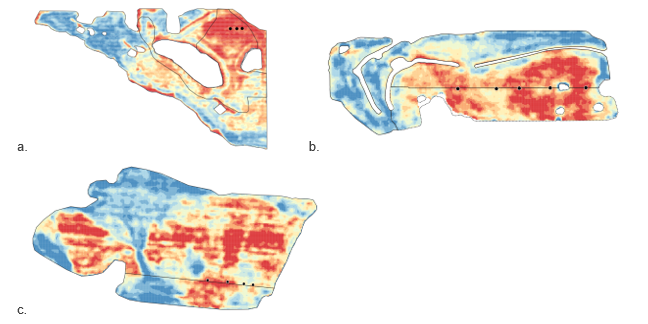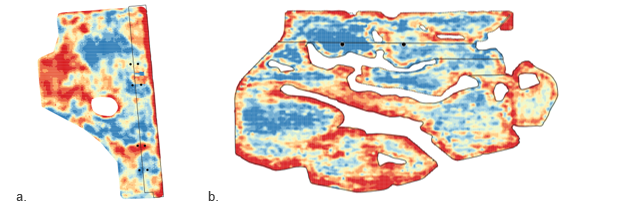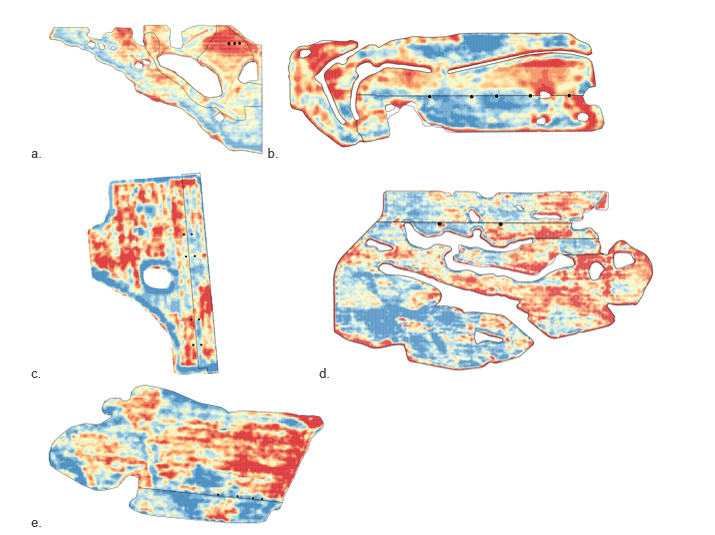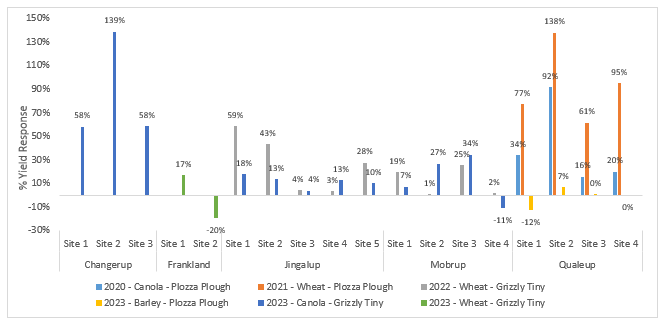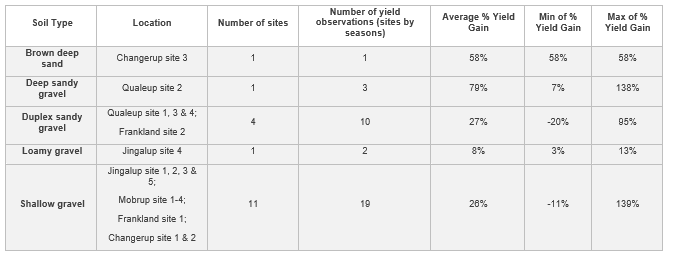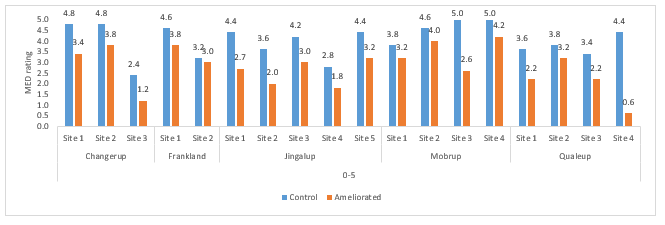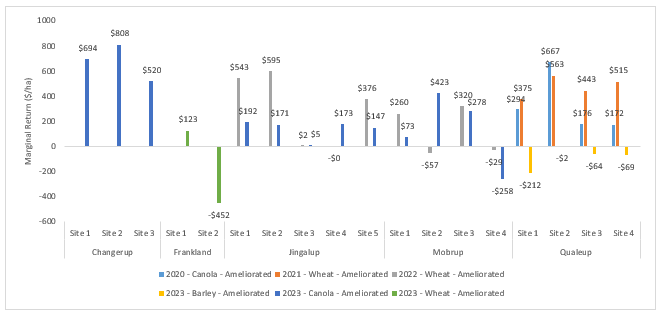Benchmarking the effect of soil mixing on crop yield and soil properties in the Great Southern
Author: Alice Butler, Bindi Isbister, Glenn McDonald, Grey Poulish, Stephen Davies, Hasin Rahman, Chris Gazey and Chris Robinson | Date: 26 Feb 2024
Key messages
- In five grower case-study paddocks in the Great Southern between 2020–2023, mechanical soil mixing increased grain yield by more than 7% compared to the adjacent untreated area for 71% of the yield observations (25 of 35 paired sites). Early-season normalised difference vegetation index (NDVI) imagery in 2023 indicated ameliorated areas at most sites had better plant growth early in the season, apart from one where the strip width was not sufficient to use 10m resolution imagery (control strip was 9m).
- The molarity of ethanol droplet (MED) rating, a measure of water repellence, of the sites ranged from severe (2.3–3.5) to very severe (>3.5) in the untreated area. The adjacent ameliorated treatment area showed a lower MED rating at all sites, with four sites still very severe, eight classified as severe, five were moderate and one was rated as low.
- The Grizzly Tiny offset disc working depth ranged from 12 –25cm. The depth of working was shallower at two sites with densely packed soil types of a duplex sandy gravel and a gravelly loam.
- Eighty-three per cent of the sites sampled had higher levels of nitrate nitrogen (mg/kg) at 10–20cm within the treatment area compared to the adjacent non-ameliorated control. Ninety-three per cent of the sites with higher nitrate nitrogen concentration at 10–20cm also had higher organic carbon percentages at the same depth, demonstrating the effect of soil mixing to incorporate the higher organic carbon topsoil deeper into the soil profile.
Aims
To understand the effectiveness of mechanical soil mixing for the management of water repellence within the Great Southern.
Introduction
In the Great Southern, growers have been undertaking mechanical soil mixing, using ‘Grizzly Tiny’ large offset disc and ‘Plozza’ modified one-way disc plough tillage implements, to manage topsoil water repellence. Due to the size of machinery and high variation in soil types it is difficult to assess the treatment effect on soil properties and grain yield, of mechanical soil amelioration at paddock level. Previous research on forest gravel soil types has shown cereal yield responses of 29% to soil inversion within one to two years and yield responses of 21% to soil inversion three years after amelioration (Davies, et al., 2019).
Method
Spatial data layers and in-season measurements were used to benchmark soil type responsiveness to soil mixing for the management of soil water repellence for five grower case study paddocks.
Historical yield data and biomass imagery (just after crop emergence) were used to understand soil type and production before mechanical soil mixing (Figures 1 and 2). Treatment strips were implemented before seeding in various years from 2020 to 2023 (Table 1). Using the historical spatial layers, 18 paired sample sites on and off the soil mixing treatment area were analysed across five paddocks, with 13 of these paired sample sites compared over multiple seasons. This produced a total of 35 yield observations.
Four paddocks were analysed for yield response to soil mixing using hand harvest cuts and one paddock was analysed using yield data collected by the farm harvester at paired sites, treated versus untreated. The sites were analysed for soil nutrients from 0–40cm, as well as assessed for a MED rating. In addition, all sites were sown with banded soil wetter (SACOA SE14TM) as part of standard seeding operation.
Marginal return refers to the rate of return from increased investment and has been used to compare the difference between the treated and adjacent control. The marginal return for the 35 yield observations from 18 paired sites was calculated using the grain yield response (difference between treated and adjacent control), with an amelioration cost of $200/ha spread over three years equating to $67/ha/year, and a five-year standardised grain price (CBH Daily Grain price less $50/tonne for levies, CBH storage and freight) at Kwinana Port FIS of $610/tonne for RR canola, $315/tonne for APW wheat and $233/tonne for feed barley.
Table 1. Paddock locations, site soil classifications, amelioration date, implement used, crop rotation and available moisture 2020–2023
Figure 1. Early season biomass imagery converted to NDVI before amelioration — a. Changerup 12 July 2020, b. Jingalup barley 7 June 2020, and c. Mobrup 7 June 2020, overlayed with soil test sites. Site one is always the most eastern or southern site (see Table 1 for description of treatment area relative to line demarcating treated and non-treated areas).
Figure 2. Multi-year yield data analysis before amelioration — a. Qualeup 2015, 2017 and 2019 barley multi-year analysis average yield 4.13t/ha and b. Frankland 2018 and 2020 canola multi-year yield analysis average yield 2.05t/ha. Site one is always the most eastern or southern site (see Table 1 for description of treatment area relative to line demarcating treated and non-treated areas).
Results
Early season NDVI indicated better plant growth early in the season (June–July) in the treated areas at four out of the five locations (Figure 3), however due to the control strip being narrow (9m) the biomass imagery (10m resolution) did not show any visual difference at Changerup.
Figure 3. 2023 early-season biomass imagery converted to NDVI — a. Changerup 12 June 2023 canola, b. Jingalup 2 July 2023 canola, c. Qualeup barley 2 July 2023 barley, d. Frankland wheat 2 July 2023 and e. Mobrup 12 June 2023 canola, overlayed with soil test sites. Site one is always the most eastern or southern site (see Table 1 for description of treatment area relative to line demarcating treated and non-treated areas).
Grain yield
Of the total 35 paired yield observations from 18 paired sample sites (taken between 2020–2023), 25 yield observations had greater than 5% yield gain when compared to the adjacent control (Figure 4). The yield response ranged from 7 to 139%. Seven yield observations had a yield response of 0-4% while three were negative, ranging from -11 to -20%.
This equated to an increase in yield of between 0.23–1.43t/ha of canola, 0.60–2.10t/ha of wheat and 0.28t/ha of barley (only one site produced a positive barley yield response). Three treated sites had a negative yield response (wheat, barley, and canola) when compared to the adjacent control and seven sites had a yield response (wheat, barley, and canola) of between zero and 5%.
Figure 4. Percentage yield response from soil mixing. For paddocks Changerup, Frankland, Jingalup and Mobrup yield collected by hand harvest cuts at paired sample sites on and off the treatment strip. For Qualeup, farm yield data was analysed in paired treatment blocks on and off the treatment strip.
When the percentage yield gain is compared by soil type (Table 2) deep sandy gravel (Qualeup site averaged over three seasons) showed the highest average yield gain of 79%, with a range of 7–138%. Brown deep sand had the second highest percentage yield gain of 58%, however this was from one paired yield observation (Changerup site 3). Duplex sandy gravel and shallow gravel had an average yield gain of 27 and 26% respectively. Duplex sandy gravel had a range of -20 to 95% yield gain, while shallow gravel had a range of
-11 to 139%. The lowest percentage yield gain was the loamy gravel (Jingalup site four) with 8%, and a range of 3–13%, however this was from only one site over two seasons.
Table 2. Percentage yield gain from soil mixing by soil types collated from 2020–2023. For Grizzly Tiny ameliorated paddocks, Changerup, Frankland, Jingalup and Mobrup, yield collected by hand harvest cuts at paired sample sites on and off the treatment strip. For Qualeup where the Plozza Plough was used, farm yield data was analysed in paired treatment blocks on and off the treatment strip.
Soil properties
Water repellence rating
Of the 18 sites, 14 had very severe (>3.5) and four had a severe (2.3–3.5) MED rating in the topsoil (0–5cm) layer (Figure 5). All treated sites had a lower MED rating compared to the adjacent control area. MED rating reductions varied greatly within each paddock with a range of 1–1.4 at Changerup, 0.2–0.8 at Frankland, 1–1.7 at Jingalup, 0.6–2.4 at Mobrup and 0.6–3.8 at Qualeup. Following amelioration four sites were still very severe, eight were severe, five were moderate and one was rated as low.
Figure 5. Molarity of ethanol droplet (MED) rating for topsoil (0–5 cm) layer. Qualeup soil samples collected in February 2022. Changerup, Frankland, Jingalup and Mobrup soil samples collected in April 2023. MED rating >3.5 is very severe, 2.3–3.5 is severe, 1.1–2.3 is moderate and 0.1–1.1 is low.
Clay and gravel
Out of the 14 Grizzly Tiny sites, clay percentage in the topsoil (0–5 cm) was lower at 12 treatment sites compared to the adjacent control (Figure 6). Gravel percentage was higher in the topsoil (0–5 cm) at nine out of 14 Grizzly Tiny treatment sites compared to the adjacent control and three out of four Plozza Plough treatment sites compared to the adjacent control area (Figure 7).
Figure 6. Clay percentage for topsoil (0–5 cm) layer at Changerup, Frankland, Jingalup and Mobrup.
Figure 7. Gravel percentage for the topsoil (0–5cm)layer at Changerup, Frankland, Jingalup, Mobrup and Qualeup.
Nitrogen and organic carbon
Of the 18 sample sites, 15 sites had higher levels of nitrate nitrogen (mg/kg) at the subsoil depth of 10–20cm within the treatment area compared to the adjacent control (Figure 9). Fourteen out of the 15 sites with higher levels of nitrate nitrogen (mg/kg) also had higher organic carbon percentages at the same depth of 10–20 cm.
Figure 9. Nitrate (mg/kg) and organic carbon (%) at 10–20 cm. Qualeup soil tested in February 2022, Changerup, Frankland, Jingalup and Mobrup were soil tested in April 2023 after > 25mm rainfall event in March.
Machine depth of working
The Grizzly Tiny depth of working was measured at the 14 sites. The machine ranged in working depth from 12–25cm (Figure 8). The shallowest depth of working was measured at Frankland site two, on a duplex sandy gravel, and Jingalup site four, where there was a very dense loamy gravel.
Figure 8. Grizzly Tiny offset disc depth-of-working at sampled sites in four case study paddocks.
Marginal return
The overall average marginal return (Figure 10.) for amelioration using the Grizzly Tiny in wheat was $153/ha (11 paired observation sites, across three paddocks) and $269/ha for canola (12 paired observation sites, across three paddocks). For the Plozza plough, compared across four paired observation sites in one paddock, the average marginal return was $327/ha for 2020 canola, $474/ha for 2021 wheat and -$87/ha for 2023 barley.
Nine yield observations, (26%of the total), produced a negative marginal return ranging from $0/ha to -$452/ha, three of these from 2022 and six from 2023. Seventy-four per cent of yield observations, (26 out of 35), delivered a positive marginal return ranging from $2/ha to $808/ha.
Figure 10. Marginal return ($/ha) of soil mixing compared to adjacent control using a Kwinana Port FIS grain price of $610/t for canola, $315/t for wheat and $233/t for barley. Cost of amelioration was estimated at $200/ha, spread over three years to equate to $67/ha/year.
Conclusion
Soil water repellence is a multi-faceted issue, affecting crop establishment and weed management, and is a key constraint in the Great Southern. Overall, soil mixing increased grain yields at 71.4% of yield observation sites and was shown to lower the topsoil (0–5cm) water repellence MED rating at all treated sites when compared to the adjacent control. However, there were large variations in percentage yield gain within soil types, such as the shallow gravel and duplex sandy gravels, over different seasons, and it is important to be mindful of the seasonal interactions and other soil constraints present.
Shallow depth of machine working negatively impacted on the yield response at one site. Within the ameliorated area at Frankland site two, the machine only reached a depth of 12cm, and the MED was reduced by a rating of 0.2 when compared to the adjacent control. Therefore, the water repellent layer was not effectively mixed deeper into the profile. In addition, this site was also a high production zone prior to amelioration and mechanical mixing may have disrupted preferred pathways of water flow created by the previous crop roots.
It is likely the dry spring experienced in 2023 also contributed to the negative yield response at Mobrup site four and site one, three and four at Qualeup. This region of the Great Southern received between 6-15 mm of rainfall at key grain fill time. Mobrup site four is a shallow gravel soil type, and experienced a negative yield response in 2023 after producing a small, likely insignificant, 2% yield increase in 2022. The control area of Mobrup site four had a MED rating of 5, the maximum rating. In the adjacent ameliorated area, the MED rating was 4.2, still very severe. Biomass imagery from 12 June 2023 showed improved establishment, compared to historical biomass imagery on 7 June 2020, before amelioration. It is possible that site four emerged better, setting up higher plant numbers with a higher water requirement, and then come spring did not have enough moisture to support the crop to finish. Similarly, at Qualeup in 2023, site one, a duplex sandy gravel, produced a negative yield response, and site three and site four (also both duplex sandy gravel) produced a nil yield response when comparing the treated area to the adjacent control. Previously in 2020 and 2021, all sites at Qualeup produced a positive response.
Within 15 out of 18 ameliorated sites, there were increased levels of nitrate nitrogen at the subsoil depth of 10-20cm and lower MED ratings when compared to the adjacent untreated control, indicating that soil mixing had been effectively. Although all treated sites showed a lower MED rating, 12 out of 18 sites are considered still either severe or very severe, indicating that this is a highly water repellent environment and it is likely water repellence will still impact on crop establishment post amelioration.
A key future priority is to understand longevity of the yield response and changes to soil properties over multiple seasons. This will allow growers to better understand the long-term benefit of mechanical amelioration in relation to soil type and season.
Acknowledgments
DAW1901-006RTX Increasing farming system profitability and longevity of benefits following soil amelioration. DAW1902-003RTX Reengineering soils to improve the access of crop root systems to water and nutrients stored in the subsoil.
The research undertaken as part of this project is made possible by the significant contributions of growers through both trial cooperation and the support of the GRDC, the author would like to thank them for their continued support.
References
Davies, S., Betti, G., Edwards, T., McDonald, G., Hall, D., Anderson, G., . . . Boyes, T. (2019). Ten years of managing water repellent soils research in Western Australia - a review of current progress and future opportunities. GRDC Research Updates. Perth: GRDC.
GRDC Project Code: DAW1901-006RTX, DAW1902-003RTX,
Was this page helpful?
YOUR FEEDBACK


